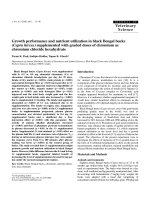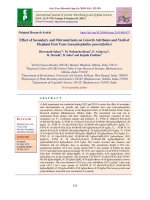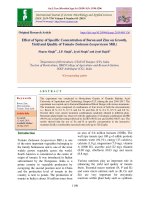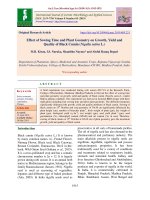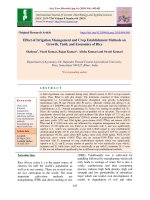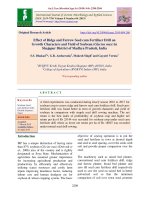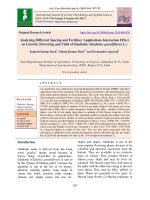Effect of fertigation on growth, phenology and nutrient status in leaves under high density orchard of citrus Sinensis Osbeck cv. Mosambi
Bạn đang xem bản rút gọn của tài liệu. Xem và tải ngay bản đầy đủ của tài liệu tại đây (227.47 KB, 9 trang )
Int.J.Curr.Microbiol.App.Sci (2019) 8(4): 202-210
International Journal of Current Microbiology and Applied Sciences
ISSN: 2319-7706 Volume 8 Number 04 (2019)
Journal homepage:
Original Research Article
/>
Effect of Fertigation on Growth, Phenology and Nutrient Status in Leaves
under High Density Orchard of Citrus sinensis Osbeck cv. Mosambi
K. Karuna, Abhay Mankar*, Ghanshyam Singh and Feza Ahmad
Department of Horticulture (Fruit & Fruit Tech.), Bihar Agricultural College, Sabour,
Bhagalpur-813210, Bihar, India
*Corresponding author
ABSTRACT
Keywords
Citrus sinensis
Osbeck cv.
Mosambi
Article Info
Accepted:
04 March 2019
Available Online:
10 April 2019
The experiment was conducted during three consecutive year i e, 2013-14, 2014-15, 201516 to show the effect of fertigation on phenology and vegetative growth of the plants and
nutrients uptake by the leaves. Result of three years pooled data showed that increase in
plant height (35.81 cm), trunk girth (4.42 mm) canopy volume (1.94 m3), growth of current
season shoot (9.08 cm), leaf area (31.52 cm2) and leaf area index (5.54) were responses
more under higher doses of fertigation i e 120 % RDF followed by 100 % RDF. The
phenological observations like bud emergence period, full bloom period, fruit set, date of
maturity, etc. were also affected by the doses of fertilizers. On the basis of above findings
it may be concluded that the different doses of fertilizers affect on vegetative growth as
well as phenological parameters of the plant.
are several technologies to increase the yield
of any crop per unit area. Technologies like
modern method of irrigation, controlled
condition structure (polyhouse, net house,
green house, etc.), high density orcharding,
fertigation, improved varieties etc. Citrus
crops are highly nutrient loving plants. Under
fertilizer management, fertigation is one of
the improved and efficient methods of
fertilizer application through which nutrients
applied directly to root zone of the plants. By
this practice fertilizer may be applied in
number of split doses which increase
efficiency use of water and fertilizer because
this technique prevents leaching of nutrients.
This practice also saves fertilizer and its
Introduction
Citrus is a leading fruit crop of the world. It is
successfully grown in tropical and subtropical climate. It belongs to family
Rutaceae. According to (Shirgure, 2012) it is
grown in more than 140 countries in the
world. India has different types of climate
which permits to grow almost all types of
horticultural crops. In India citrus is grown in
almost all parts of the country. Land is limited
so there is little scope of area expansion under
any crops. To fulfill the demand of increased
population our country has a major task to
increase production and productivity of each
crop without expansion of their area. There
202
Int.J.Curr.Microbiol.App.Sci (2019) 8(4): 202-210
application cost (Solaimalai et al., 2015 and
Singh et al., 2010).
was depicted in (Table 1). The initial soil data
were recorded and depicted in (Table 2).
Normally the experimental plot had leveled
surface with good fertility level.
Out of 16 essential elements of the plant,
NPK are very critical elements for the plants.
It takes part in many metabolic activities in
the plants. Nitrogen is a prime element for
vegetative growth which is a constituent of
amino acids, amino sugars, amines,
nucleoprotein, polypeptide. Phosphorus is
also a constituent of phospholipids, nucleic
acids and many energy releasing compounds
etc. Potassium in plants acts as a co-factor for
various metabolic activities. According to Sah
et al., (2014) potassium acts as catalyst in
enzymatic reaction and also coupling with
amino acids and form peptides. Citrus are
more responsive crop in respect to show the
deficiency symptoms. So, about this crop
more information is required for proper
growth of the plant. Fertigation is a new
technique for application of fertilizer along
with irrigation water and have potential to
save water and fertilizer (Koo, 1981; Haynes,
1985 and Shirgure, 2013). In Bihar condition
Citrus sinensis Osbeck cv. Mosambi have no
commercial orchard but scattered planting
performing good in respect of yield and
quality. Orchardists have lack of knowledge
about fertilizer doses as well as fertigation
scheduling to keep the plants healthy for
proper yield and quality. Keeping the above
facts in view the present experiment was laid
out to study the ―Effect of fertigation for
better health of plants, yield and quality under
high density orchard of Citrus sinensis
Osbeck cv. Mosambi‖.
The trial was carried out on four years of
plants with seven fertigation level in
randomized block design based on
recommended dose of fertilizer (RDF) i.e.
300:90:90 gram/plant/year during first year
and doses increased @ 100g,75g,75g
NPK/year respectively upto three years. The
treatments were T1- 120% of RDF; T2- 100%
of RDF; T3- 80% of RDF; T4- 60% of RDF;
T5- 40% of RDF; T6- 100% RDF in basal
with drip irrigation and T7- 100 % RDF in
basal without drip irrigation. The treatment
T1, T2, T3, T4, T5 were applied in split doses
whereas, treatment T6 and T7 applied directly
in plant basin. Fertigation scheduling was
done at monthly interval starting from
November. The sources of fertilizer were urea
for nitrogen and mono potassium phosphate
and sulfate of potash for phosphorus and
potassium. The experiment was started on
four years old Mosambi plants which were
planted under high density planting (HDP), at
a spacing of 3.0 × 2.5 m.
Procedure
The phenological observations like growth of
current season shoot, plant height, canopy
volume and trunk girth were measured form
four selected shoots in four directions of the
plants, before and after fertigation with the
help of measuring tape during August.
Canopy volume was calculated according to
formula given by Roose et al., (1986). The
leaf area index (LAI) of selected plants was
measured by using the instrument canopy
analyser (LP-80, PAR/LAI Ceptometer,
Decagon Devices, Inc., WA, USA). The
reproductive parameters were recorded by
visiting the experimental orchard frequently
after bud emergence to fruit maturity. The
Materials and Methods
The experiment was conducted at Bihar
Agricultural University Sabour, Bihar, under
high density orchard during 2013-14, 201415, and 2015-16. The weather of Bihar is subtropical in nature. It is slightly arid in
summer, rainfall moderate and cold winter
203
Int.J.Curr.Microbiol.App.Sci (2019) 8(4): 202-210
physiological parameter in terms of leaf area
of fifty fully expanded leaves from each
treatment was recorded using leaf area meter
(CI-203 CA, CID Biosciences, Camas, USA).
For leaf nutrient analysis leaf samples were
collected from each treatment at maturity
stage i.e in August –September. The nitrogen
content was estimated by Kjeltec 2300 (Fose
Tecator) and phosphorus was determined by
vanado-molybdate color reaction method. The
potassium content in leaves was estimated by
flame photometer. Total micronutrients
present in leaves were estimated by Atomic
Absorption Spectrophotometer with the help
of different candled present in it. Boron
content in leaves was estimated as per method
given by Adhikari et al., (1993). The
parameters related to yield characters were
calculated just after harvesting of fruits as
well as by frequently visiting the orchard.
treatments in the field. This might be due to
the influence of environmental factors on
these parameters. In this experiment as the
nitrogen levels were increased the tendency of
emergence of bud showed delayed because
nitrogenous fertilizer favours vegetative
growth condition for a longer period that’s
why delayed bud emergence whereas
phosphate helps in flowering. So, a balance
proportion of NPK helps in flowering as well
as fruit setting in citrus. Wassel et al., (2007)
observed that higher dose of nitrogen
application favours in increase in number of
fruits in the plant. A better combination of
phosphate and potash may result to enhance
the anthesis period. Hence, a balance
combination of NPK fertilization may results
in early fruit setting. The same findings in
relation to early flowering and fruiting
through right proportion of NPK fertilization
was observed by Sah et al., (2014) in pear.
Date of maturity also influenced by
nitrogenous fertilizer as dose of nitrogen
increased the maturity period delayed and this
might be due to excess nitrogen makes fruit
skin thick and leathery (Jacob and Uexkull,
1958). Contrary to this, it is more pronounced
that phosphorus decreases the maturity period
(Lekvinadze, 1972 and Ghosh et al., 1981).
So, all major nutrients play an important role
in maturity of fruits and this result are in
confirmation with the findings of Choudhary
(1984) and Nirgude et al., (2016) in
Mosambi.
Statistical analysis
The experimental data were subjected to
statistical analysis in order to find out which
of the treatments showed significant variation
in different parameters studied under
investigation. The technique of analysis of
variance (ANOVA) for randomized block
design (RBD) was adopted as suggested by
Panse and Sukhatme (1967).
Results and Discussion
Reproductive parameters
Vegetative parameters
The results obtained by the effect of various
fertigation treatments on reproductive
parameters of Mosambi under Bihar condition
were carefully recorded and depicted in Table
3. These parameters might be helpful to the
orchardist as well as scientist of Bihar
condition (sub-tropical) for time of all cultural
practices imposed in the field as well as in
hybridization programme. Although, no much
more variations were observed among the
Data related to vegetative characteristics have
been significantly differed by different
fertilizer doses through fertigation are
presented in Table 4. The treatment T2
showed the maximum length of current
season shoot (9.11 cm) whereas minimum
(7.24 cm) was recorded under T4 which was at
par with rest of the treatments. In respect of
increase in plant height maximum (35.81 cm)
204
Int.J.Curr.Microbiol.App.Sci (2019) 8(4): 202-210
was observed in T1 followed by T2 while
minimum (20.74 cm) in T5. Data regarding to
increase in trunk girth was significantly
differed among treatments. Highest increase
in trunk girth was recorded in T1 and T2 (4.42
mm) which was followed by T3, T4 and T6
whereas lowest in T5 and T7. Leaf area was
found highest in T1 (31.52 cm2) followed by
T2 (29.98 cm2) and T7 (28.63 cm2). The
lowest leaf area (26.23 cm2) was showed in T5
which was at par with T3, T4 and T6. The
maximum LAI (Leaf Area Index) was
observed in T1 (5.54) followed by T2 (5.22)
which intern at par with T3 (5.08) while
minimum (4.04) under T5 followed by T4, T5
and T7. Significantly maximum canopy
volume (1.94 m3) was recorded in T1 which
was at par with T2 and T6 followed by T4, T7
and T3 while lowest in T5.
Table.1 Four years average meteorological data from 2014 to 2017
Months
Temperature
(oC)
Relative Humidity
(%)
Rainfall
(cm)
Wind speed
(Km/hr.)
Max.
Min.
7.00
AM
2.00 PM
January
21.4
8.6
94.6
64.5
20.1
2.8
February
25.6
10.7
89.2
53.6
11.4
2.5
March
30.8
15.7
81.0
47.8
9.2
4.1
April
35.7
20.7
72.1
42.3
26.6
6.4
May
36.1
23.9
77.3
52.4
106.5
7.5
June
34.4
25.4
83.1
64.9
113.8
5.9
July
32.0
25.4
89.5
77.6
353.6
6.1
August
32.4
25.5
89.4
76.5
242.0
5.3
September
32.3
24.8
89.2
76.3
203.4
3.6
October
30.4
20.1
89.2
67.7
91.1
2.1
November
28.9
14.5
87.9
54.9
0.0
1.3
December
23.1
9.6
94.4
64.5
0.1
2.1
Table.2 Initial soil nutrient status of experimental plot before fertigation of different fertilizer
Soil depth
(cm)
pH (1:2.5) EC
(ds/m)
Organic C
(%)
N
(Kg/ha.)
P2O5
(Kg/ha.)
K2O
(Kg/ha.)
0 -15
7.21
0.43
0.48
200.7
28.08
128.1
15 - 30
7.18
0.40
0.41
326.1
29.99
136.8
205
Int.J.Curr.Microbiol.App.Sci (2019) 8(4): 202-210
Table.3 Effect of fertigation on phenology of Citrus sinensis cv. Mosambi
Pooled data of 2013-14, 2014-15 and 2015-16
Treatments
Duration of bud
emergence
Days Duration of anthesis
T1- 120 % RDF
11th Feb
21st Feb
11
3rd March
10th
March
08
6th March 14th
March
09
18th October
T2- 100 % RDF
13th Feb
22nd Feb
10
2nd March
10th
March
09
5th March 15th
March
11
18th October
T3- 80 % RDF
13th Feb
21st Feb
09
27th Feb
11th
March
13
4th March 15th
March
12
20th October
T4- 60 % RDF
14th Feb
21st Feb
08
28th Feb
13th
March
14
4th March 17th
March
14
22nd October
T5- 40 % RDF
14th Feb
22nd Feb
09
27th Feb
12th
March
14
3rd March 16th
March
14
23rd October
T6- 100 % RDF
with drip
irrigation
13th Feb
21st Feb
09
3rd March
13th
March
11
6th March 18th
March
13
25th October
T7- 100 % RDF
without drip
irrigation
15th Feb
24th Feb
10
6th March
15th
March
10
9thMarch
11
30th October
206
Days Duration of fruit set
19th
March
Days Date of
maturity
Int.J.Curr.Microbiol.App.Sci (2019) 8(4): 202-210
Table.4 Effect of fertigation on vegetative parameters of Citrus sinensis cv. Mosambi
Treatments
T1- 120 % RDF
T2- 100 % RDF
T3- 80 % RDF
T4- 60 % RDF
T5- 40 % RDF
T6- 100 % RDF
with drip
irrigation
T7- 100 % RDF
without drip
irrigation
CD (P = 0.05)
SEm (+)
Pooled data of 2013-14, 2014-15 and 2015-16
Current
Increase
Increase
Leaf
season
in plant
in trunk
area
shoot (cm) height(cm) girth (cm)
(cm2)
9.08
35.81
4.42
31.52
9.11
30.39
4.42
29.98
7.91
27.73
4.22
26.99
7.24
24.87
4.14
26.63
7.45
20.74
3.89
26.23
8.09
28.24
4.19
27.73
LAI
5.54
5.22
5.08
4.60
4.04
4.48
Canopy
volume
(cm3)
1.94
1.81
1.60
1.62
1.38
1.75
7.31
27.66
4.08
28.63
4.48
1.62
0.40
0.87
4.38
2.01
0.09
0.18
0.95
1.93
0.13
0.26
0.20
0.11
Table.5 Effect of fertigation on nutrient status in leaves of Citrus sinensis cv. Mosambi
Treatments
T1- 120 % RDF
T2- 100 % RDF
T3- 80 % RDF
T4- 60 % RDF
T5- 40 % RDF
T6- 100 % RDF
with drip
irrigation
T7- 100 % RDF
without drip
irrigation
CD (P = 0.05)
SEm (+)
Pooled data of 2013-14, 2014-15 and 2015-16
N
P
K
Zn
Cu
Fe
2.08
0.14
0.84
23.45
4.99 243.57
2.16
0.15
0.84
23.57
4.51 221.97
1.97
0.15
0.80
21.01
5.00 204.50
1.89
0.13
0.77
20.56
5.75 188.31
1.77
0.14
0.78
20.30
5.16 186.96
1.94
0.14
0.83
21.91
5.60 200.37
Mn
52.33
47.66
50.60
42.96
38.72
35.87
B
45.19
42.88
40.36
40.91
32.02
34.42
1.88
0.12
0.75
19.81
3.95
163.62
36.15
25.86
0.16
0.08
0.05
0.02
0.08
0.04
1.51
0.69
2.19
1.00
27.91
12.81
11.05
5.07
5.10
2.34
Almost all vegetative parameters showed
better under higher doses of fertilizer in
treatment T1 and this might be due to high
fertilizer use efficiency because NPK were
applied to the plants in many split doses from
vegetative growth to maturity of the fruits
which helped to overcome the requirements
of essential nutrients during critical growth
periods. These data also supported by the
findings of Ramana et al., (2014) who found
maximum plant growth when higher NPK
dose were supplied in the sweet orange. The
207
Int.J.Curr.Microbiol.App.Sci (2019) 8(4): 202-210
results of Kachwaya and Chandel (2015) are
also in agreement with the findings of above
results. Ahmad et al., (2010) also reported
that nitrogenous fertilizers are positively
correlated to vegetative growth in sweet
cherry. The growth parameters like canopy
volume in Valencia trees were found highest
under higher dose of fertilizer i.e. 720 g N
(Menino et al., 2003). The data related to LAI
was also supported by Chatterjee (2013) who
worked on tomato and found that highest
nitrogen
application
among
various
treatments are responsible for highest value of
LAI.
ppm) in T1 which was at par with T2, T3 and
T4 while lowest (25.86 ppm) in T7. It may be
concluded that the higher doses of NPK
leaves contain higher amount of micronutrient and this might be due to the regular
supply of balanced dose of NPK and water
throughout the growing period resulted in
maintaining the physical properties of soil to
absorb more nutrient Ramana et al., (2014)
and Shirgure and Srivastava (2013).
On the basis of above results and discussion it
may be concluded that higher dose i.e 120 %
of RDF was found best in respect of all
parameters like reproductive parameters,
vegetative parameters as well as nutritional
parameters in leaves in Mosambi. It might be
due to plants were in growing period and
response of fertilizer doses were positively
showed in the field.
Nutritional parameters
Three years of pooled data related to Citrus
sinensis cv. Mosambi of leaf nutrient status
have been analyzed and presented in Table 5.
The highest nitrogen content (2.16 %) was
recorded in T2 which was at par with T1
followed by T3 and T6 whereas minimum
(1.77 %) in T5 which was at par with T4 and
T7. Data related to phosphorus content in
leaves of Mosambi was found non-significant
differences among treatments but the value of
phosphorus in leaves were found sufficient in
range. Potassium content in leaves was also
found non-significant differences. It was
ranged between 0.75 to 0.84 % and it was
found insufficient in range from reference
value. Highest Zn content (23.57 ppm) in
Mosambi leaves was found in T2 which was
at par with T1 followed by T6 while lowest
(19.81 ppm) in T7 which was at par with T3,
T4 and T5. Data regarding to Cu content
showed non-significant effect among the
treatments. Fe content was found maximum
(243.57 ppm) in T1 which was at par with T2
(221.97 ppm) while minimum (163.62 ppm)
in T7 which showed parity to T4 and T5. Data
in respect to Mn content in leaves, highest
(52.33 ppm) under T1 which was at par with
T2, T3 and T4 whereas lowest (35.87 ppm) in
T6. Likewise, B content was highest (45.19
References
Ahmad, M.F., Samantan, A. and Jabeen, A.
(2010). Response of sweet cherry
(Prunus avium) to fertigation of
nitrogen, phosphorus and potassium
under Kerawa land of Kashmir valley.
Indian J. Agric. Sci., 80(6): 512-516.
Adhikari T, Mondal AK, De DK, Mandal B
(1993) Influence of organic matter and
lime application on boron availability
in soils. Ind J Agric Sci 63: 803-806.
Barnes, J.D., Balaguer, L., Manrique, E.,
Elvira, S. and Davison, A.W. (1992).
A reappraisal of the use of DMSO for
the extraction and determination of
chlorophylls a and b in lichens and
higher plants. Environ. Experi. Bot.,
32: 85-100.
Chatterjee, R. (2013). Physiological attributes
of tomato (Lycopersicon esculentum
Mill.) influenced by different sources
of nutrients at foothill of eastern
Himalayan region. J. Appl. Natur. Sci.,
5(2): 282-287.
208
Int.J.Curr.Microbiol.App.Sci (2019) 8(4): 202-210
Choudhary, R. (1984). The effects of selective
combination of N, P & K on growth,
yield and quality of sweet orange
(Citrus
sinensis,
Osbeck)
cv.
Mosambi. M. Sc. Thesis, Rajendra
Agricultural University, BAC, Sabour,
Bihar.
Ghosh, S.P., Verma, A.N. and Govind, S.
(1981). Rejuvenating citrus orchards
in North- Eastern Hill region, Indian
J. Hort., 26(1): 20-24.
Haynes, R.J. (1985). Principles of fertilizer
use for trickle irrigated crops. Ferti.
Res., 6: 235-255.
Jacob, A. and Uexkull, H.V. (1958). Fertilizer
use nutrition and manuring of tropical
crops. Centred‟Etude de Azote,
Hannover.
Kachwaya, D.S. and Chandel, J.S. (2015).
Effect of fertigation on growth, yield,
fruit quality and leaf nutrients content
of strawberry (Fragaria × ananassa)
cv. Chandler. Indian J. Agric. Sci., 85
(10): 1319-23.
Koo, R.C.J. (1981). Results of citrus
fertigation studies. Proc. Florida Stat.
Hort. Soci., 93: 33-36.
Lekvinadze, P.A. (1972). The effect of
different superphosphate rates on
some quality indices in satsumas.
Subtropicheskie Kul' tury, (5): 83-88.
Menino, M.R., Corina, C., Amarilis, V.,
Victor, V.A. and Jose, B. (2003). Tree
size and flowering intensity as
affected by nitrogen fertilization in
non-bearing orange trees grown under
Mediterranean conditions. J. Plant
Physiol., 160: 1435-1440.
Nirgude V, Karuna K, Mankar A, Kumar V,
Spandana M (2016) Response of NPK
fertigation on pheno-physiological
status of Citrus sinensis Osbeck cv
Mosambi under high density planting.
J Appl Nat Sci 8: 1306-1311.
Panse, V.G. and Sukhatme, P.V. (1967).
Statistical methods for agricultural
workers,
Indian
Council
of
Agricultural Research, New Delhi.
Ramana, K.T.V., Lakshmi, L.M., Gopal, K.,
Krishna, V.N.P.S., Lakshmi, T.,
Sarada, G., Gopi, V. and Sankar, T.G.
(2014). Nitrogen and Potassium Based
Fertigation Response on Plant Growth,
Yield and Quality of Sweet Orange
(Citrus sinensis Osbeck) cv. Sathgudi.
Research and Reviews: J. Agric.
Allied Sci., 3(3).
Roose, M.L., Col, D.A., Atkin, D. and Kuper,
R.S. (1986). Yield and tree size of
four citrus cultivars on 21 root stocks
in California. J. Amer. Soci. Hort. Sci.,
114: 135-140.
Sah, H., Pratibha, Kumar, R. and Topwal, M.
(2014). Response of NPK on growth,
yield and quality of oriental pear: A
Review. Indian Hort. J., 4 (1): 01-08.
Shirgure PS (2013). Citrus fertigation – a
technology of water and fertilizers
saving. Sci J Crop Sci 2 : 56—66.
Shirgure PS, Srivastava AK (2013) Plant
growth, leaf nutrient status, fruit yield
and quality of Nagpur mandarin
(Citrus
reticulata
Blanco)
as
influenced
by
potassium
(K)
fertigation with four potash fertilizer
sources. Sci J Crop Sci 2 : 36-42.
Shirgure, P.S. (2012). Micro-irrigation
systems, automation and fertigation in
Citrus. Scientific J. Rev., 1 (5): 156169.
Shirgure, P.S. (2013). Yield and fruit quality
of Nagpur mandarin (Citrus reticulata
Blanco) as influenced by evaporation
based drip irrigation schedules.
Scientific J. Crop Sci., 2 (2): 28-35.
Singh, R.M., Singh, D.K., and Rao, K.V.R.
(2010). Fertigation for increased crop
yield and fertilizer saving. Agric.
Engi. Today, 34 (2).
Solaimalai, A., Baskar, M., Sadasakthf, A.
and Subburamu, K. (2015). Fertigation
in high value crops – A review. Agric.
209
Int.J.Curr.Microbiol.App.Sci (2019) 8(4): 202-210
Rev., 26 (1): 1-13.
Wassel, A.H., Ahmed, F.F., Ragab, M.A. and
Ragab, M.M. (2007). Response of
Balady mandarin trees to drip
irrigation and nitrogen fertigation IIEffect of nitrogen fertigation and drip
irrigation on fruit setting, number and
quality of fruits of Balady mandarin
trees (Citrus reticulata). Afric. Crop
Sci. Conf. Proc., 8: 513-522.
Weatherley, P.E. (1950). Studies in the water
relations of the cotton plant. I. The
field measurement of water deficits in
leaves. New Phytol., 49: 81-87.
How to cite this article:
Karuna, K., Abhay Mankar, Ghanshyam Singh and Feza Ahmad. 2019. Effect of Fertigation on
Growth, Phenology and Nutrient Status in Leaves under High Density Orchard of Citrus
sinensis Osbeck cv. Mosambi. Int.J.Curr.Microbiol.App.Sci. 8(04): 202-210.
doi: />
210
